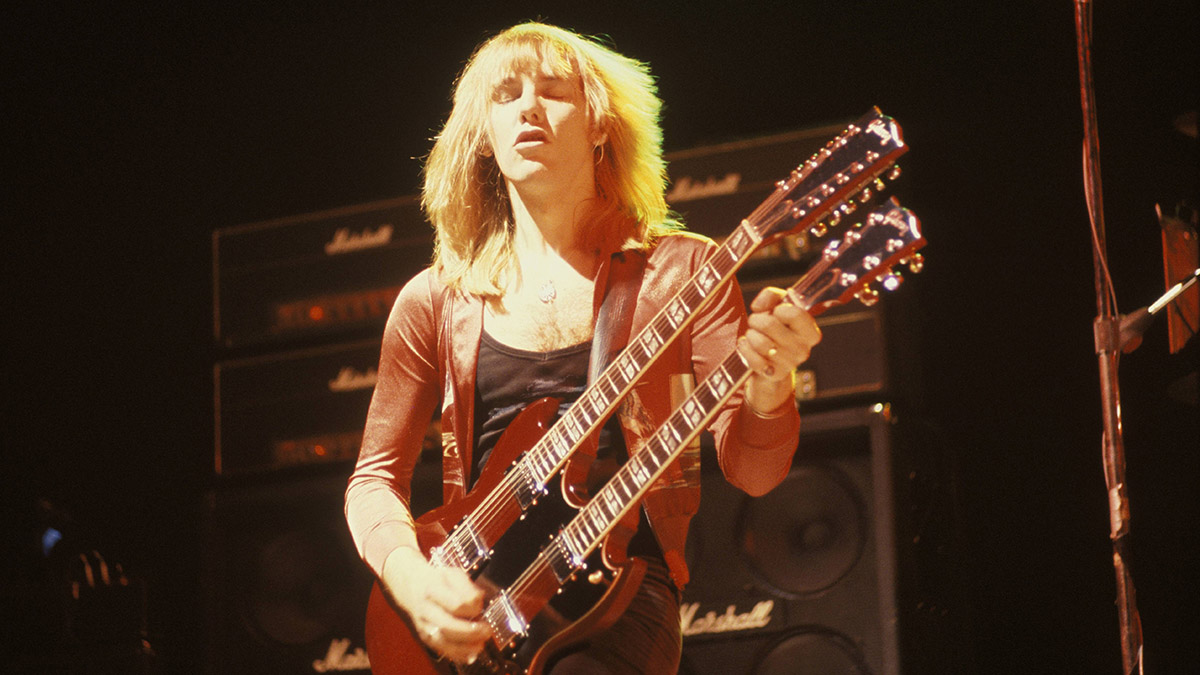Learn the rhythm and lead styles of Rush’s Alex Lifeson
These two studies demonstrate how Lifeson marries rhythmic intrigue to imaginative melodic and harmonic themes to create Rush's life-affirming prog-rock sound

Prior to the death of drummer Neil Peart in 2020, Canadian progressive rock band Rush had enjoyed a 40-plus year career that saw them headline countless stadiums, sell millions of records, and influence a new generation of prog rockers.
Although they were formed in 1968, it was the power trio line up of Peart, who also wrote the band’s lyrics, guitar player Alex Lifeson and bass player and lead vocalist Geddy Lee that rose to prominence and achieved huge acclaim around the world.
Rush have changed and blended their style and sound over the years, from blues-rock beginnings, to more heavily progressive influenced rock in the ’70s, into synth-driven prog-pop in the ’80s, and back to guitar-driven rock after that.
However, complex rhythms and inventive melodic and harmonic phrasing have always been at the forefront of their music. Before the death of Peart, the band had ceased to officially function in 2018, but their legacy lives on.
As well as many awards over the years, they were inducted into the Rock And Roll Hall Of Fame in 2013. One particularly impressive achievement is that they are ranked fifth in the list of artists to achieve consecutive gold or platinum album sales in America.
The band was initially influenced by British rock groups, such as Pink Floyd, Genesis, Led Zeppelin and Cream and have themselves gone on to influence bands like Dream Theater, Rage Against The Machine and Metallica.
Alex Lifeson’s guitar style draws upon his own influences from his childhood, such as Jimi Hendrix, Jeff Beck and Jimmy Page, and the rock riffs, intricate rhythms and melodic lead phrasing of these players can be heard in his playing.
Additionally, in the 1980s, when Rush’s music leant more heavily on synths, Lifeson began to use effects in similar ways to players such as U2’s The Edge to carve out a particular sound.
The track this month does have a synth line in it, but it’s definitely more rock than pop, with an element of prog in the changing time signatures. We’re in the key of E Minor E-F#-G-A-B-C-D, and unlike many of the more blues based tracks from this column, the recording sticks to that key without any non-diatonic notes, other than one Bb chromatic note in the first section.
You will also notice a time signature change from 4/4 to 7/8, and to play this accurately you just need to count 1-2-3-4-5-6-7 as you play it for the first couple of times, and you should find that it all fits into place easily.
In general, the track has an andante 92bpm tempo, so you may find yourselves initially counting 1-and-2-and-3-and-4 + for the 4/4 section and then 1-2-3-4-5-6-7 for the 7/8 section. As always, enjoy!
Get the tone
Amp settings: Gain 6, Bass 5, Middle 5, Treble 6, Reverb 3
Alex Lifeson spent much of his time in Rush playing Gibson Les Paul and ES-335 guitars, so use a bridge position humbucker if possible, or knock back the treble if using single-coils.
A lightly overdriven Marshall type sound should get you in the right place tonally, and effects such as delay and chorus will add the required prog-rock lushness to your chords and licks.
Example 1. Rhythm
The main rhythm guitar chords are lightly palm muted throughout, adding to the staccato feel of the track.
Make sure the arpeggiated chords are played cleanly (chorus will sound great on these), and that the open third string rings for all of bars 9-16.
Example 2. Solo
In bar 28 the G note has some random semi-pinched harmonics, so dig in a little more and let your picking-hand fingernail catch the string as you play these notes.
Get The Pick Newsletter
All the latest guitar news, interviews, lessons, reviews, deals and more, direct to your inbox!
“There are so many sounds to be discovered when you get away from using a pick”: Jared James Nichols shows you how to add “snap, crackle and pop” to your playing with banjo rolls and string snaps
Don't let chord inversions bamboozle you. It's simply the case of shuffling the notes around









![Joe Bonamassa [left] wears a deep blue suit and polka-dotted shirt and plays his green refin Strat; the late Irish blues legend Rory Gallagher [right] screams and inflicts some punishment on his heavily worn number one Stratocaster.](https://cdn.mos.cms.futurecdn.net/cw28h7UBcTVfTLs7p7eiLe.jpg)


